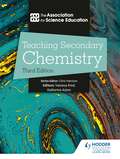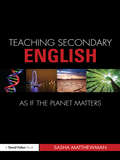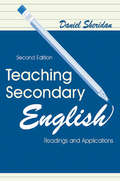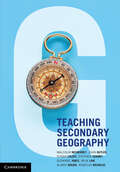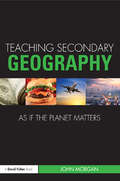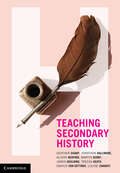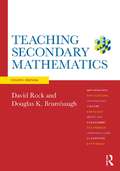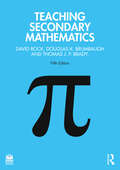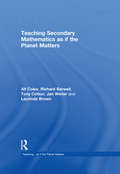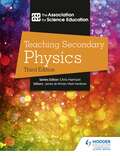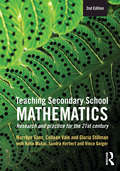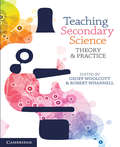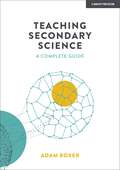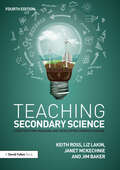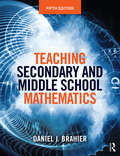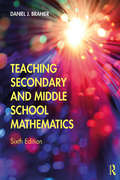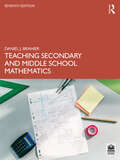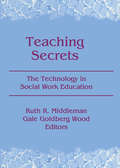- Table View
- List View
Teaching Secondary Chemistry 3rd Edition
by The Association EducationEnhance your teaching with expert advice and support for Key Stages 3 and 4 Chemistry from the Teaching Secondary series - the trusted teacher's guide for NQTs, non-specialists and experienced teachers. Written in association with ASE, this updated edition provides best practice teaching strategies from academic experts and practising teachers.- Refresh your subject knowledge, whatever your level of expertise - Gain strategies for delivering the big ideas of science using suggested teaching sequences - Engage students and develop their understanding with practical activities for each topic - Enrich your lessons and extend knowledge beyond the curriculum with enhancement ideas - Improve key skills with opportunities to introduce mathematics and scientific literacy highlighted throughout - Support the use of technology with ideas for online tasks, video suggestions and guidance on using cutting-edge software - Place science in context; this book highlights where you can apply science theory to real-life scenarios, as well as how the content can be used to introduce different STEM careers Also available: Teaching Secondary Biology, Teaching Secondary Physics
Teaching Secondary English as if the Planet Matters
by Sasha Matthewman‘This is an important book for all concerned with the teaching and learning of English, exploring new and hugely significant areas in a scholarly, thought-provoking and eminently practical way.’ – David Stevens, University of Durham, UK Drawing together ideas from a range of disciplines in the study of texts which explore nature, the built environment and issues of climate change and environmental stress, this book shows how English is well placed to develop the cultural, aesthetic and emotional response to environmental themes – both as part of everyday practice and within wider curriculum innovations. Features include: critical reflection on the teaching of secondary English connections with the academic study of ecocriticism and/or key environmental issues suggested teaching activities and/or reflections from classroom practice sources of further reading and information. The true worth of a school subject is revealed in how far it can account for and respond to the major issues of the time. This timely textbook breaks new ground in showing how English teachers can have a pivotal role in responding to the environmental crisis.
Teaching Secondary English: Readings and Applications
by Daniel SheridanThis new edition of Teaching Secondary English is thoroughly revised, but its purpose has not changed. Like the popular first edition, it balances content knowledge with methodology, theory with practice, and problem-posing with suggested solutions. The tone and format are inviting, while addressing student-readers on a professional level. Rather than attempting to cover everything, the text provides a framework and materials for teaching a secondary English methods course, while allowing considerable choice for the instructor. The focus is on teaching literature, writing, and language--the basics of the profession. Attention is given to the issues that arise as one seeks to explore what it means to "teach English." The problems and tensions of becoming a teacher are discussed frankly, in a manner that helps students figure out their own attitudes and solutions. Features: * Focuses on a few central concepts in the teaching of secondary English * Provides an anthology of 22 readable and challenging essays on key topics--allowing students to hear a variety of voices and opinions * Includes an applications section for each reading that extends the discussion and asks students to explore problems and grapple with important issues related to the articles * Offers short writing assignments in questions that follow the readings and in brief writing tasks in the applications, and a longer writing assignment at the end of each chapter * Addresses student readers directly without talking down to them New in the Second Edition: * This edition is shorter, tighter, and easier to use. * The opening and concluding chapters more directly address the concerns of new teachers. * The anthology is substantially updated (of the 22 articles included, 14 are new to this edition). * Each essay is preceded by a brief introduction and followed by questions for further thought. * There are fewer applications, but these are more extensive and more fully integrated within the text. * A writing assignment is provided at the end of each chapter. * Interviews with college students--before and after student teaching--are included in Chapters 1 and 6. * The bibliographies at the end of each chapter are fully updated.
Teaching Secondary Geography
by John Butler Malcolm McInerney Susan Caldis Stephen Cranby Alaric Maude Susanne Jones Michael Patrick Law Rebecca NicholasGeography is not only the study of the surface of the planet and the exploration of spatial and human - environment relationships, but also a way of thinking about the world. Guided by the Australian Curriculum and the Professional Standards for Teaching School Geography (GEOGstandards), Teaching Secondary Geography provides a comprehensive introduction to both the theory and practice of teaching Geography. This text covers fundamental geographical knowledge and skills, such as working with data, graphicacy, fieldwork and spatial technology, and provides practical guidance on teaching them in the classroom. Each chapter features short-answer and 'Pause and Think' questions to enhance understanding of key concepts, and 'Bringing It Together' review questions to consolidate learning. Classroom scenarios and a range of information boxes are provided throughout to connect students to additional material. Written by an author team with extensive teaching experience, Teaching Secondary Geography is an exemplary resource for pre-service teachers.
Teaching Secondary Geography as if the Planet Matters (Teaching... as if the Planet Matters)
by John Morgan'Teaching Geography as if the Planet Matters provides a timely outline of powerful knowledge and arguments that will be needed to counter a strengthening of current curriculum orthodoxies. Not until school geography undergoes the revolution that this book outlines can it honestly claim to be contributing to more sustainable futures.' - John Huckle, Visiting Fellow at the University of York and was formerly Principal Lecturer in Educaton at De Montfort University. We are surrounded by images and warnings of impending environmental disaster. Climate change, famine, population growth and urban crisis coupled with more recent financial chaos all threaten our sense of what it will be like to live in the future. This thought-provoking text looks at how Geography teachers can develop approaches to curriculum and learning which help students understand the nature of the contemporary world. It sets out a model for teaching and learning that allows teachers to examine existing approaches to teaching and draw upon the insights of geography as a discipline to deepen students’ understanding of urban futures, climate change, ‘geographies of food’ and the ‘geographies of the credit crunch’. Features include: examples of suggested teaching activities questions and activities for further study detailed case studies sources of further reading and information The true worth of a school subject is revealed in how far it can account for and respond to the major issues of the time. The issue of the environment cuts across subject boundaries and requires an interdisciplinary response. Geography teachers are part of that response and they have a crucial role in helping students to respond to environmental issues and representations.
Teaching Secondary History
by Martin Kerby Heather Sharp Alison Bedford Jonathon Dallimore James Goulding Treesa Clare Heath Darius von Guttner Louise ZarmatiTeaching Secondary History provides a comprehensive introduction to the theory and practice of teaching History to years 7–12 in Australian schools. Engaging directly with the Australian Curriculum, this text introduces pre-service teachers to the discipline of History. It builds on students' historical knowledge, thinking and skills and offers practical guidance on how to construct well-rounded History lessons for students. From inquiry strategies and teacher- and student-centred practice, to embedding the cross-curriculum priorities in planning and assessment, this text supports the learning and development of pre-service History teachers by connecting the 'big ideas' of teaching with the nuance of History content. Each chapter features short-answer and Pause and think questions to enhance understanding of key concepts, Bringing it together review questions to consolidate learning, classroom scenarios, examples of classroom work and a range of information boxes to connect students to additional material.
Teaching Secondary Mathematics
by David Rock Douglas K. BrumbaughSolidly grounded in up-to-date research, theory and technology, Teaching Secondary Mathematics is a practical, student-friendly, and popular text for secondary mathematics methods courses. It provides clear and useful approaches for mathematics teachers, and shows how concepts typically found in a secondary mathematics curriculum can be taught in a positive and encouraging way. The thoroughly revised fourth edition combines this pragmatic approach with truly innovative and integrated technology content throughout. Synthesized content between the book and comprehensive companion website offers expanded discussion of chapter topics, additional examples and technological tips. Each chapter features tried-and-tested pedagogical techniques, problem solving challenges, discussion points, activities, mathematical challenges, and student-life based applications that will encourage students to think and do. New to the 4th edition: A fully revised and updated chapter on technological advancements in the teaching of mathematics Connections to both the updated NCTM Focal Points as well as the new Common Core State Standards are well-integrated throughout the text Problem solving challenges and sticky questions featured in each chapter to encourage students to think through everyday issues and possible solutions. A fresh interior design to better highlight pedagogical elements and key features A companion website with chapter-by-chapter video lessons, teacher tools, problem solving Q&As, helpful links and resources, and embedded graphing calculators.
Teaching Secondary Mathematics
by David Rock Douglas K. Brumbaugh Thomas J. BradySolidly grounded in up-to-date research, theory, and technology, Teaching Secondary Mathematics is a practical, student-friendly, and popular text for secondary mathematics methods courses. It provides clear and useful approaches for mathematics teachers and shows how concepts typically found in a secondary mathematics curriculum can be taught in a positive and encouraging way. The thoroughly revised fifth edition combines this pragmatic approach with truly innovative and integrated technology content throughout. Synthesized content between the book and a comprehensive Instructor and Student Resource website offers expanded discussion of chapter topics, additional examples, and technological tips, such as using and assessing artificial intelligence.Each chapter features tried-and-tested pedagogical techniques, problem-solving challenges, discussion points, activities, mathematical challenges, and student-life-based applications that will encourage students to think and do.New to the fifth edition: A fully revised chapter on technological advancements in the teaching of mathematics, including the use of artificial intelligence A new chapter on equity, shame, and anxiety in the mathematics classroom Connections to both the updated National Council of Teachers of Mathematics (NCTM) Focal Points and Standards Problem-solving challenges and sticky questions featured in each chapter to encourage students to think through everyday issues and possible solutions A fresh interior design to better highlight pedagogical elements and key features A completely updated Instructor and Student Resource site with chapter-by-chapter video lessons, teacher tools, problem solving Q&As, exercises, and helpful links and resources.
Teaching Secondary Mathematics as if the Planet Matters (Teaching... as if the Planet Matters)
by Richard Barwell Tony Cotton Alf Coles Jan Winter Laurinda Brown‘This book moves us beyond a theoretical pondering of the issues and makes concrete suggestions for teachers and students for how things can be different in mathematics classrooms. This is long overdue.’ Peter Gates, University of Nottingham Teaching Mathematics as if the Planet Matters explores how Mathematics teachers can develop approaches to curriculum and learning which help students understand the nature of the contemporary world. It sets out a model for teaching and learning that allows teachers to examine existing approaches to teaching and draw upon the insights of mathematics as a discipline to help students relate classroom mathematics to global issues such as climate change, the economy, food supplies, biodiversity, human rights, and social justice. Including practical examples, suggestions for teaching activities and detailed further reading sections, the book covers: the mathematics of description in the measuring, recording and statistical analysis that informs our knowledge of climate change, consumption and sustainability; the mathematics of prediction in the modelling used by governments, scientists and businesses to plan roads, power stations and food supplies and their effects; the mathematics of communication in the news reports, blogs and environmental campaigns, incomplete without graphs, charts and statistics. The true worth of a school subject is revealed in how far it can account for and respond to the major issues of the time. The issue of the environment cuts across subject boundaries and requires an interdisciplinary response. Mathematics teachers are part of that response and they have a crucial role in helping students to respond to environmental issues and representations.
Teaching Secondary Physics 3rd Edition
by The Association EdEnhance your teaching with expert advice and support for Key Stages 3 and 4 Physics from the Teaching Secondary series - the trusted teacher's guide for NQTs, non-specialists and experienced teachers. Written in association with ASE, this updated edition provides best practice teaching strategies from academic experts and practising teachers.- Refresh your subject knowledge, whatever your level of expertise - Gain strategies for delivering the big ideas of science using suggested teaching sequences - Engage students and develop their understanding with practical activities for each topic - Enrich your lessons and extend knowledge beyond the curriculum with enhancement ideas - Improve key skills with opportunities to introduce mathematics and scientific literacy highlighted throughout - Support the use of technology with ideas for online tasks, video suggestions and guidance on using cutting-edge software - Place science in context; this book highlights where you can apply science theory to real-life scenarios, as well as how the content can be used to introduce different STEM careers Also available: Teaching Secondary Chemistry, Teaching Secondary Biology
Teaching Secondary Physics 3rd Edition
by The Association EducationEnhance your teaching with expert advice and support for Key Stages 3 and 4 Physics from the Teaching Secondary series - the trusted teacher's guide for NQTs, non-specialists and experienced teachers. Written in association with ASE, this updated edition provides best practice teaching strategies from academic experts and practising teachers.- Refresh your subject knowledge, whatever your level of expertise - Gain strategies for delivering the big ideas of science using suggested teaching sequences - Engage students and develop their understanding with practical activities for each topic - Enrich your lessons and extend knowledge beyond the curriculum with enhancement ideas - Improve key skills with opportunities to introduce mathematics and scientific literacy highlighted throughout - Support the use of technology with ideas for online tasks, video suggestions and guidance on using cutting-edge software - Place science in context; this book highlights where you can apply science theory to real-life scenarios, as well as how the content can be used to introduce different STEM careers Also available: Teaching Secondary Chemistry, Teaching Secondary Biology
Teaching Secondary School Mathematics: Research and practice for the 21st century
by Merrilyn Goos Gloria Stillman Sandra Herbert Vince GeigerSince its first publication, Teaching Secondary School Mathematics has established itself as one of the most respected and popular texts for both pre-service and in-service teachers. This new edition has been fully revised and updated to reflect the major changes brought about by the introduction of the Australian Curriculum: Mathematics, as well as discussing significant research findings, the evolution of digital teaching and learning technologies, and the implications of changes in education policies and practices.The mathematical proficiencies that now underpin the Australian curriculum -- understanding, fluency, problem solving and reasoning -- are covered in depth in Part 1, and a new section is devoted to the concept of numeracy. The chapter on digital tools and resources has been significantly expanded to reflect the growing use of these technologies in the classroom, while the importance of assessment is recognised with new material on assessment for learning and as learning, along with a consideration of policy development in this area. Important research findings on common student misconceptions and new and effective approaches for teaching key mathematical skills are covered in detail.As per the first edition readers will find a practical guide to pedagogical approaches and the planning and enactment of lessons together with enhanced chapters on teaching effectively for diversity, managing issues of inequality and developing effective relationships with parents and the community.This book is the essential pedagogical tool for every emerging teacher of secondary school mathematics.'The text offers an excellent resource for all of those involved in the preparation of secondary mathematics teachers, with links to research literature, exemplars of classroom practices, and instructional activities that encourage readers to actively examine and critique practices within their own educational settings.' Professor Glenda Anthony, Institute of Education, Massey University'A rich and engaging textbook that covers all of the important aspects of learning to become an effective secondary mathematics teacher. The second edition of this text ... is further enhanced with updated references to the Australian Curriculum, NAPLAN, STEM, current Indigenous, social justice and gender inequity issues, and the place of Australian mathematics curricula on the world stage.' Dr Christine Ormond, Senior Lecturer, Edith Cowan University
Teaching Secondary Science
by Geoff Woolcott Robert WhannellTeaching Secondary Science: Theory and Practice provides a dynamic approach to preparing preservice science teachers for practice. Divided into two parts - theory and practice - the text allows students to first become confident in the theory of teaching science before showing how this theory can be applied to practice through ideas for implementation, such as sample lesson plans. These examples span a variety of age levels and subject areas, allowing preservice teachers to adapt each exercise to suit their needs when they enter the classroom. Each chapter is supported by pedagogical features, including learning objectives, reflections, scenarios, key terms, questions, research topics and further readings. Written by leading science education researchers from universities across Australia, Teaching Secondary Science is a practical resource that will continue to inspire preservice teachers as they move from study into the classroom. This book includes a single-use twelve-month subscription to Cambridge Dynamic Science.
Teaching Secondary Science: A Complete Guide
by Adam BoxerTeaching science is no simple task. Science teachers must wrestle with highly abstract and demanding concepts, ideas which have taken humanity's greatest minds thousands of years to formulate and refine. Communicating these great and awesome theories involves careful forethought and planning. We need to deliver crystal clear explanations, guide students as they develop their embryonic knowledge and then release them to develop their thinking independently, all the while curating and tending to their long-term understanding as it develops over time.In Teaching Secondary Science: A Complete Guide, Adam breaks down the complex art of teaching science into its component parts, providing a concrete and comprehensive set of evidence-informed steps to nurturing brilliant science students. Adam hopes that you find this book interesting, but his main aim is for you to find it useful. Useful when it comes to sketching out your curriculum, useful when preparing your explanations, useful for mapping out how you will check student understanding and useful for all other aspects of science teaching. This is a truly complete guide, and science teachers of any experience will find it packed with ideas that are new, challenging, interesting and, most importantly, useful.
Teaching Secondary Science: A Complete Guide
by Adam BoxerTeaching science is no simple task. Science teachers must wrestle with highly abstract and demanding concepts, ideas which have taken humanity's greatest minds thousands of years to formulate and refine. Communicating these great and awesome theories involves careful forethought and planning. We need to deliver crystal clear explanations, guide students as they develop their embryonic knowledge and then release them to develop their thinking independently, all the while curating and tending to their long-term understanding as it develops over time.In Teaching Secondary Science: A Complete Guide, Adam breaks down the complex art of teaching science into its component parts, providing a concrete and comprehensive set of evidence-informed steps to nurturing brilliant science students. Adam hopes that you find this book interesting, but his main aim is for you to find it useful. Useful when it comes to sketching out your curriculum, useful when preparing your explanations, useful for mapping out how you will check student understanding and useful for all other aspects of science teaching. This is a truly complete guide, and science teachers of any experience will find it packed with ideas that are new, challenging, interesting and, most importantly, useful.
Teaching Secondary Science: Constructing Meaning and Developing Understanding
by Keith Ross Liz Lakin Janet McKechnie Jim BakerThe fourth edition of Teaching Secondary Science has been fully updated and includes a wide range of new material. This invaluable resource offers a new collection of sample lesson plans and includes two new chapters covering effective e-learning and advice on supporting learners with English as a second language. It continues as a comprehensive guide for all aspects of science teaching, with a focus on understanding pupils’ alternative frameworks of belief, the importance of developing or challenging them and the need to enable pupils to take ownership of scientific ideas. This new edition supports all aspects of teaching science in a stimulating environment, enabling pupils to understand their place in the world and look after it. Key features include: Illustrative and engaging lesson plans for use in the classroom Help for pupils to construct new scientific meanings M-level support materials Advice on teaching ‘difficult ideas’ in biology, chemistry, physics and earth sciences Education for sustainable development and understanding climate change Managing the science classroom and health and safety in the laboratory Support for talk for learning, and advice on numeracy in science New chapters on e-learning and supporting learners with English as a second language. Presenting an environmentally sustainable, global approach to science teaching, this book emphasises the need to build on or challenge children’s existing ideas so they better understand the world in which they live. Essential reading for all students and practising science teachers, this invaluable book will support those undertaking secondary science PGCE, school-based routes into teaching and those studying at Masters level.
Teaching Secondary and Middle School Mathematics
by Daniel J. BrahierTeaching Secondary and Middle School Mathematics combines the latest developments in research, standards, and technology with a vibrant writing style to help teachers prepare for the excitement and challenges of teaching secondary and middle school mathematics today. In the fully revised fifth edition, scholar and mathematics educator Daniel Brahier invites teachers to investigate the nature of the mathematics curriculum and reflect on research-based "best practices" as they define and sharpen their own personal teaching styles. The fifth edition has been updated and expanded with a particular emphasis on the continued impact of the Common Core State Standards for Mathematics and NCTM’s just-released Principles to Actions, as well as increased attention to teaching with technology, classroom management, and differentiated instruction. Features include: A full new Chapter 7 on selection and use of specific tools and technology combined with "Spotlight on Technology" features throughout clearly illustrate the practical aspects of how technology can be used for teaching or professional development. Foundational Chapters 1 and 2 on the practices and principles of mathematics education have been revised to build directly on Common Core State Standards for Mathematics and Principles to Actions, with additional references to both documents throughout all chapters. A new Chapter 4 focuses on the use of standards in writing objectives and organizing lesson plan resources while an updated Chapter 5 details each step of the lesson planning process. A fully revised Chapter 12 provides new information on teaching diverse populations and outlines specific details and suggestions for classroom management for mathematics teachers. Classroom Dialogues" features draws on the author’s 35-year experience as an educator to present real-world teacher-student conversations about specific mathematical problems or ideas "How Would You React?" features prepares future teachers for real-life scenarios by engaging them in common classroom situations and offering tried-and-true solutions. With more than 60 practical, classroom-tested teaching ideas, sample lesson and activities, Teaching Secondary and Middle School Mathematics combines the best of theory and practice to provide clear descriptions of what it takes to be an effective teacher of mathematics.
Teaching Secondary and Middle School Mathematics
by Daniel J. BrahierTeaching Secondary and Middle School Mathematics combines the latest developments in research, technology, and standards with a vibrant writing style to help teachers prepare for the excitement and challenges of teaching secondary and middle school mathematics. The book explores the mathematics teaching profession by examining the processes of planning, teaching, and assessing student progress through practical examples and recommendations. Beginning with an examination of what it means to teach and learn mathematics, the reader is led through the essential components of teaching, concluding with an examination of how teachers continue with professional development throughout their careers. Hundreds of citations are used to support the ideas presented in the text, and specific websites and other resources are presented for future study by the reader. Classroom scenarios are presented to engage the reader in thinking through specific challenges that are common in mathematics classrooms. The sixth edition has been updated and expanded with particular emphasis on the latest technology, resources, and standards. The reader is introduced to the ways that students think and how to best meet their needs through planning that involves attention to differentiation, as well as how to manage a classroom for success. Features include: The entire text has been reorganized so that assessment takes a more central role in planning and teaching. Unit 3 (of 5) now addresses the use of summative and formative assessments to inform classroom teaching practices. ● A new feature, "Links and Resources," has been added to each of the 13 chapters. While the book includes a substantial listing of citations and resources after the chapters, five strongly recommended and practical resources are spotlighted at the end of each chapter as an easy reference to some of the most important materials on the topic. ● Approximately 150 new citations have either replaced or been added to the text to reflect the latest in research, materials, and resources that support the teaching of mathematics. ● A Quick Reference Guide has been added to the front of the book to assist the reader in identifying the most useful chapter features by topic. ● A significant revision to Chapter 13 now includes discussions of common teaching assessments used for field experiences and licensure, as well as a discussion of practical suggestions for success in methods and student teaching experiences. ● Chapter 9 on the practical use of classroom technology has been revised to reflect the latest tools available to classroom teachers, including apps that can be run on handheld, personal devices. An updated Instructor’s Manual features a test bank, sample classroom activities, Powerpoint slides, chapter summaries, and learning outcomes for each chapter, and can be accessed by instructors online at www.routledge.com/9780367146511
Teaching Secondary and Middle School Mathematics
by Daniel J. BrahierTeaching Secondary and Middle School Mathematics combines the latest developments in research, technology, and standards with a vibrant writing style to help teachers prepare for the excitement and challenges of teaching secondary and middle school mathematics. The book explores the mathematics teaching profession by examining the processes of planning, teaching, and assessing student progress through practical examples and recommendations. Beginning with an examination of what it means to teach and learn mathematics, the reader is led through the essential components of teaching, concluding with an examination of how teachers continue with professional development throughout their careers. Hundreds of citations are used to support the ideas presented in the text, and specific websites and other resources are presented for future study by the reader. Classroom scenarios are presented to engage the reader in thinking through specific challenges that are common in mathematics classrooms. The seventh edition has been updated and expanded with particular emphasis on the latest technology, standards, and other resources. The reader is introduced to the ways that students think and how to best meet their needs through planning that involves attention to differentiation, as well as how to manage a classroom for success. Features include: • Following on from the sixth edition, assessment takes a central role in planning and teaching. Unit 3 (of 5) addresses the use of summative and formative assessments to inform classroom teaching practices. • A new appendix is included that lists websites that can be used in a methods class to view other teachers interacting with students for discussion of effective teaching practices. • The feature entitled “Links and Resources” has been updated in each of the 13 chapters. Five strongly recommended and practical resources are spotlighted at the end of each chapter as an easy reference to some of the most important materials on the topic. • Approximately 150 new citations have either replaced or been added to the text to reflect the latest in research, materials, and resources that support the teaching of mathematics. • Significant revisions have been made to Chapter 12, which now includes updated research and practices as well as a discussion on culturally responsive pedagogy. Likewise, Chapter 8 now includes a description of best and high-leverage teaching practices, and a discussion in Chapter 11 on alternative high school mathematics electives for students has been added. • Chapter 9, on the practical use of classroom technology, has again been revised to reflect the latest tools available to classroom teachers, including apps that can be run on handheld personal devices, in light of changes in education resulting from the global pandemic. An updated Instructor’s Manual features a test bank, sample classroom activities, PowerPoint slide content, chapter summaries, and learning outcomes for each chapter, and can be accessed by instructors online at www.routledge.com/9781032472867.
Teaching Secrets: The Technology in Social Work Education
by Ruth Middleman Gale Goldberg WoodTeachers and student teachers in social work will gain valuable insight into the artistry that makes truly great teaching from the accounts found in this new book. Master teachers examine the processes they use in the classroom and present them in a format that facilitates the practical application of their ideas. The teaching methods recounted here emphasize the learners as the most important component of the teaching/learning experience and demonstrate techniques to enliven and enhance the reader’s own teaching methods. This vital book focuses on teaching “technologies,” defined as bodies of knowledge or skills ordered for use, that are comprised of techniques or systematic procedures that bring the technologies to life. By utilizing the techniques and technologies portrayed in this volume, social work educators at the graduate and undergraduate levels will become more effective at reaching their students and helping them grow into professional social workers.Teaching Secrets helps teachers increase the effectiveness of their teaching by demonstrating how to pay attention to acts and nuances that stimulate and assist students in their learning. Individual chapters focus on specific classroom environments, providing practical advice to improve learning in each situation. Social work teachers will discover more effective teaching through the use of student journals, the use of self in teaching doctoral research, the use of authority, and the benefits of student-student learning in work groups. Other chapters offer practical advice on reaching different groups of students such as black teachers leading white students, white teachers leading black students, and special efforts for reaching female students. This exciting book reveals that great teachers are not born but made, and shares the secrets that will help all social work educators to develop greatness in their own classrooms.
Teaching Sexuality and Religion in Higher Education: Embodied Learning, Trauma Sensitive Pedagogy, and Perspective Transformation (Routledge Research in Religion and Education)
by Kate Ott Darryl W. StephensThis volume combines insights from secular sexuality education, trauma studies, and embodiment to explore effective strategies for teaching sexuality and religion in colleges, universities, and seminaries. Contributors to this volume address a variety of sexuality-related issues including reproductive rights, military prostitution, gender, fidelity, queerness, sexual trauma, and veiling from the perspective of multiple religious faiths. Christian, Jewish, and Muslim scholars present pedagogy and classroom strategies appropriate for secular and religious institutional contexts. By foregrounding a combination of "perspective transformation" and "embodied learning" as a means of increasing students’ appreciation for the varied social, psychological, theological and cultural contexts in which attitudes to sexuality develop, the volume posits sexuality as a critical element of teaching about religion in higher education. This book will be of great interest to graduate and postgraduate students, researchers, academics, and libraries in the fields of Religious Studies, Religious Education, Gender & Sexuality, Religion & Education, and Sociology of Religion.
Teaching Shakespeare in Primary Schools: All the World's a Stage
by Stefan Kucharczyk Maureen KucharczykTeaching Shakespeare in Primary Schools offers guidance and practical ideas for teaching Shakespeare’s plays across Key Stage 1 and 2. It demonstrates how the plays can engage young readers in exciting, immersive and fun literacy lessons and illustrates how the powerful themes, iconic characters and rich language remain relevant today. Part 1 explores the place of classic texts in modern classrooms – how teachers can invite children to make meaning from Shakespeare’s words – and considers key issues such as gender and race, and embraces modern technology and digital storytelling. Part 2 presents Shakespeare’s plays: The Tempest, A Midsummer Night’s Dream, Romeo and Juliet, Julius Caesar, Macbeth and The Winter’s Tale. For each play, there is a suggested sequence of activities that will guide teachers through the process of inspiring children, incubating ideas and making connections all before responding to it through drama, writing and other subjects. You don’t need to be an actor, a scholar or even an extrovert to get the best out of Shakespeare! Written by experienced teachers, this book is an essential resource for teachers of all levels of experience who want to teach creative, engaging and memorable lessons.
Teaching Signature Thinking: Strategies for Unleashing Creativity in the Classroom
by Kevin S. Krahenbuhl John Lando CarterHow do you help students uncover and hone their innate talents to create works that are uniquely their own, works worthy of their signatures? This unique new book guides teachers with practical, research-based strategies that can be used to make creativity the new normal in classrooms. You’ll learn how to equip students with the knowledge necessary to innovate in a field, and how to help students embrace a risk-ready environment. You’ll also find out how to help students tinker and build prototypes through project-based learning. With the step-by-step guidance in this book, students will be able to bring their creativity to life and will be more prepared to leave their mark on the world.
Teaching Singing in the 21st Century
by Scott D. Harrison Jessica O'BryanThis volume brings together a group of leading international researchers and practitioners in voice pedagogy alongside emerging academics and practitioners. Encompassing research across voice science and pedagogy, this innovative collection transcends genre boundaries and provides new knowledge about vocal styles and approaches from classical and musical theatre to contemporary commercial music. The work is sure to be valuable in tertiary institutions, schools and community music associations, suitable for use by private studio teachers, and will appeal to choral leaders and music educators interested in vocal pedagogy. "I thoroughly enjoyed reading this book and I am confident it will help bring all aspects of vocal pedagogy firmly into the 21st century. Refreshingly, many different areas of pedagogy are included in the text so we can all work together to more fully understand the singing voice. Up to the moment research is included along with an exploration of the evolving contemporary styles of singing. Further, areas regarding teaching and curriculum in higher education are also reviewed. All in all, this text a crucial addition to a professional's vocal library. " Jeanne Goffi-Fynn, Teachers College, Columbia University, USA.
Teaching Skills For Dummies
by Sue CowleyBeing a "good teacher" is a difficult goal to achieve, being largely dependent on a huge variety of skills outside of the main curriculum. Teaching Skills For Dummies focuses on these 'soft' skills of teaching, from maintaining discipline to creating engaging lesson plans and monitoring performance. This essential guide promises to help teachers gain the respect of their pupils, manage potential confrontations and ultimately get the best out of both their careers and their students.Teaching Skills For Dummies includes information on:Developing Your Teaching StyleTeaching a ClassManaging a ClassDealing with Different Kinds of PeopleSucceeding Beyond the Classroom "Don't let the title fool you; this is an essential guide and resource for any aspiring teacher. Sue Cowley uses her experience and insight to provide a comprehensive and informative resource, packed with excellent advice and brilliant suggestions for making both teaching and learning effective. A must for any teacher's bookshelf!" - Peter Hadfield, Principal lecturer in Education, University of Bedfordshire
